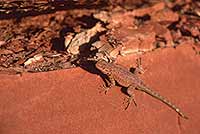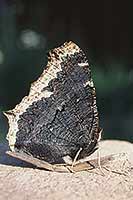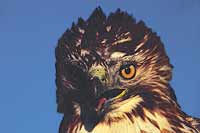Signs of Spring |
|
Spring in the desert is a mixed bag. Days of sunshine and 65° F weather may be punctuated with intermittent snow storms or sand-blasting winds that peel the enamel right off your teeth. You can experience four seasons in one day, but eventually the weather calms down. Besides the unstable weather patterns, there are other clues that herald the coming of spring. One of the coolest spring sights is the emergence of garter snakes from their underground winter dens. Resembling a wriggling ball of string, these entwined snakes leave their burrow and exfoliate with each snake going its own way. Of course, the birds are also a tell-tale sign that spring is in motion. Most of the rough-legged hawks that wintered in areas like the Cisco Desert have departed, heading northwards to their Arctic and tundra breeding grounds. The local rodent population may be breathing a collective sigh of relief, but that is short lived. Ferruginous, red-tailed and Swainson’s hawks return to their breeding grounds and keep up the predatory pressure on these rodents that the rough-leggeds exerted in winter.
There is also the appearance of sparrows and songbirds absent over the winter. Though some of these migrants will continue on, some will stay and raise their young here. The Say’s phoebe, a small flycatcher with a brownish-yellow belly and plaintive call, is among the first to appear. Though lacking an aerial assemblage of insects upon which to feed, the Say’s relies upon insect hatches due to the warm soil and where the emergent adults stay low to the ground. Of course the local rodent and small mammal population has been active all winter, but now their attention is directed towards mating and starting the first of several broods for the season. These animals form the foundation of a prey base that hawks and eagles, coyotes and kit foxes, and a whole host of other predators depends upon. Their success rate for raising young is tied to this foundation. But of all the signs of spring, it is the appearance of the mourning cloak butterfly that gets my vote for herald of spring. These dark-winged butterflies overwinter as adults and emerge from their hiding locations as the weather warms. They are not butterflies of morning, but rather resembled the dark woolen cloaks Europeans wore in the 1800s while mourning the loss of a loved one. That these delicate creatures survived the winter hiding beneath a loose flake of bark or within the protective confines of a rotting log is just amazing to me. Then again, spring is a pretty incredible time here in the desert.
|

 The appearance of side-blotched and tree lizards are a good indicator of spring, but these creatures can be a bit fickle. If temperatures are high enough in winter, these lizards may emerge from their winter slumbers. Relying on external heat, these cold-blooded creatures have small bodies and don’t require a huge jump in temperature for them to become active. The warmer temps may also stir up the insect populations upon which these lizards feast.
The appearance of side-blotched and tree lizards are a good indicator of spring, but these creatures can be a bit fickle. If temperatures are high enough in winter, these lizards may emerge from their winter slumbers. Relying on external heat, these cold-blooded creatures have small bodies and don’t require a huge jump in temperature for them to become active. The warmer temps may also stir up the insect populations upon which these lizards feast.  Rafts of waterfowl bunch up on the rivers and in the wetlands, their push to the north driven by daylight and the need to establish breeding sites. Many of these ducks and geese are already engaged in courtship rituals and pair bonding; another way to maximize their brief time during the breeding season. Gadwalls and goldeneyes, teal and wigeons, an amazing assemblage of waterfowl passes through this land of little rain, following the rivers or jumping from one puddle-sized lake to the next.
Rafts of waterfowl bunch up on the rivers and in the wetlands, their push to the north driven by daylight and the need to establish breeding sites. Many of these ducks and geese are already engaged in courtship rituals and pair bonding; another way to maximize their brief time during the breeding season. Gadwalls and goldeneyes, teal and wigeons, an amazing assemblage of waterfowl passes through this land of little rain, following the rivers or jumping from one puddle-sized lake to the next. Adding to the springtime theme, buds of cottonwoods swell and some of the early wildflowers like Parry’s lomatium or Canyonlands biscuitroot start to bloom. These early wildflowers depend upon insect pollinators and often the flowers produce a foul smell to help attract flies. Shrubs such as serviceberry may have open flower buds before the leaves open, and a south-facing Oregon grape growing in a protective location might also have its fragrant blooms unfurled.
Adding to the springtime theme, buds of cottonwoods swell and some of the early wildflowers like Parry’s lomatium or Canyonlands biscuitroot start to bloom. These early wildflowers depend upon insect pollinators and often the flowers produce a foul smell to help attract flies. Shrubs such as serviceberry may have open flower buds before the leaves open, and a south-facing Oregon grape growing in a protective location might also have its fragrant blooms unfurled.